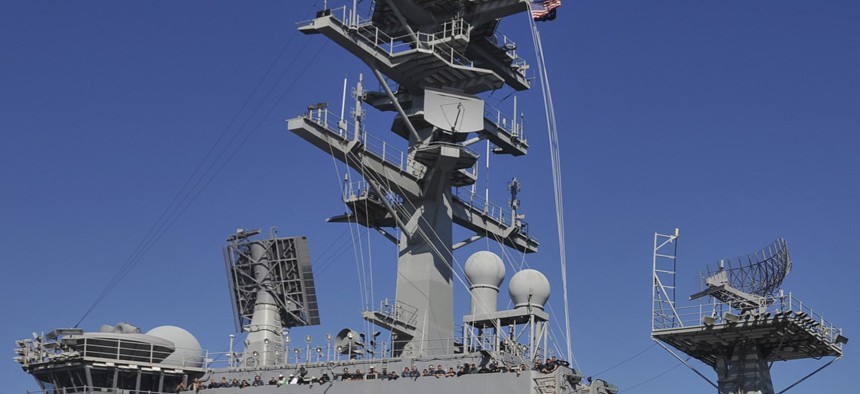
On November 3rd, 2014, an F-35C Lightning II carrier variant Joint Strike Fighter conducts it’s first arrested landing aboard the aircraft carrier USS Nimitz (CVN 68). Nimitz is underway conducting routine training exercises. KELLY M. AGE / U.S. NAVY
The F-35 Has To Phone Texas Before Taking Off
Recent tests revealed the F-35 flies well enough, but not without calling Texas first. By Patrick Tucker.
This story has been updated.
The U.S. military ran the F-35 Joint Strike Fighter through a series of tests aboard the USS Nimitz super carrier in San Diego in early November. It performed adequately, with one exception -- it needed to send its diagnostic data to Lockheed Martin in Fort Worth, Texas, before taking off. If the most recent exercises are any indication, the F-35 may need to phone home every time it sets out on a mission.
First, the good news. The plane flew through its aerial paces well enough and passed a majority of its flight tests.
"The test team accomplished 100 percent of the threshold test points and 88 percent of the objective points during deployment, completing 33 test flights (39.2 flight hours) and 124 arrested landings, of 124 attempts, including one night flight with two catapult launches and two arrested landings. The results of the test were still in analysis at this time,” Pentagon spokesperson Air Force Maj. Eric Badger told Defense One.
Pilots gave the plane high marks, telling U-T San Diego writer Jeanette Steele that the plane’s handling was “responsive” and describing the experience as “fun.” The tests were originally scheduled for July but were postponed because of problems with the jets’ nosewheel steering motor, the arresting hook system, and, of course, this summer’s engine failure.
The possible bad news to emerge from the recent tests is this: The Nimitz didn’t have the plane’s Autonomic Logistics Information Systems, ALIS, on board and so the team had to implement a “workaround.” ALIS is the F-35’s notoriously buggy diagnostic system that can ground fully functional aircraft.
History may one day call ALIS the most frustrating, expensive and counter-productive piece of software engineering that the military has ever created. It’s so bad it’s been on “60 Minutes.” In February 2014, CBS News Pentagon correspondent David Martin showed that ALIS was resistant to human override instructions even when it was forcefully grounding a plane because of a part mislabeled in a database. It was the worst sort of tyrant, both blind and powerful.
"She looks basically like a laptop computer, and the pilot carries it out to the plane and sticks it in a slot right next to him in the cockpit. That contains all the information about the mission he's going to fly," Martin said in his report on the F-35. "The servers which run all of this software take up a room about the size of a shipping container."
ALIS has a rather strained relationship with Air Force Lt. Gen. Christopher Bogdan, the man in charge of the F-35 Program, as Military.com’s Brendan McGarry reported in February, Bogdan has few kind words for the system.
“ALIS doesn’t always work right and it is not the font of all knowledge about the airplane because I got maintainers out there who fix the airplane, I’ve got pilots who go out and pre-fly the airplane, and everyone in the enterprise thinks the airplane is ready to go except ALIS,” Bogdan told a defense budget conference. In terms of manual overrides, Bogden said “we need to start doing that… We can’t do that wholesale, but we need to do that in a measured way.”
The Nimitz testing team’s “workaround” streamed the plane’s diagnostic data to technicians at Lockheed Martin in Fort Worth, Texas. That, in turn, allowed them “to process the necessary maintenance actions” so the tests could proceed.
Is it a big deal? The main point of ALIS is to reduce repair and maintenance time for ground crews aboard ships like the Nimitz. Here’s how Lockheed explains it in an information card. “ALIS receives Health Reporting Codes while the F-35 is still in flight via an radio frequency downlink. The system enables the pre-positioning of parts and qualified maintainers on the ground, so that, when the aircraft lands, downtime is minimized and efficiency is increased.”
The Pentagon has not yet said whether the issue that kept all the ALIS equipment off the Nimitz was related to the difficulty of integrating a shipping container worth of servers into the ship’s structure, the software (up to 8 million lines of code and counting for the F-35) or something else.
If the military’s super stealth fighter is expected to out-shoot, out-jam and out-fly similar Chinese or Russian craft, it should be able to take off without calling Texas first.
Update:
Joe DellaVedova, Public Affairs Director F-35 Lightning II Joint Program Office contacted Defense One about this story. He says that while previous versions of ALIS did not allow for a human override, "this has been corrected in the latest fielded release (ALIS 1.0.3)."
He adds: "ALIS continues to mature per its development roadmap and we currently have it installed aboard the USS Wasp today to support of an operational test and evaluation of the F-35B air system which will happen this spring. There is also a more portable, modularized version of the ALIS Standard Operating Unit server for shipboard and expeditionary operations that is currently in final integration and test. This version will support the U.S. Marine Corps initial operating capability later this year."




